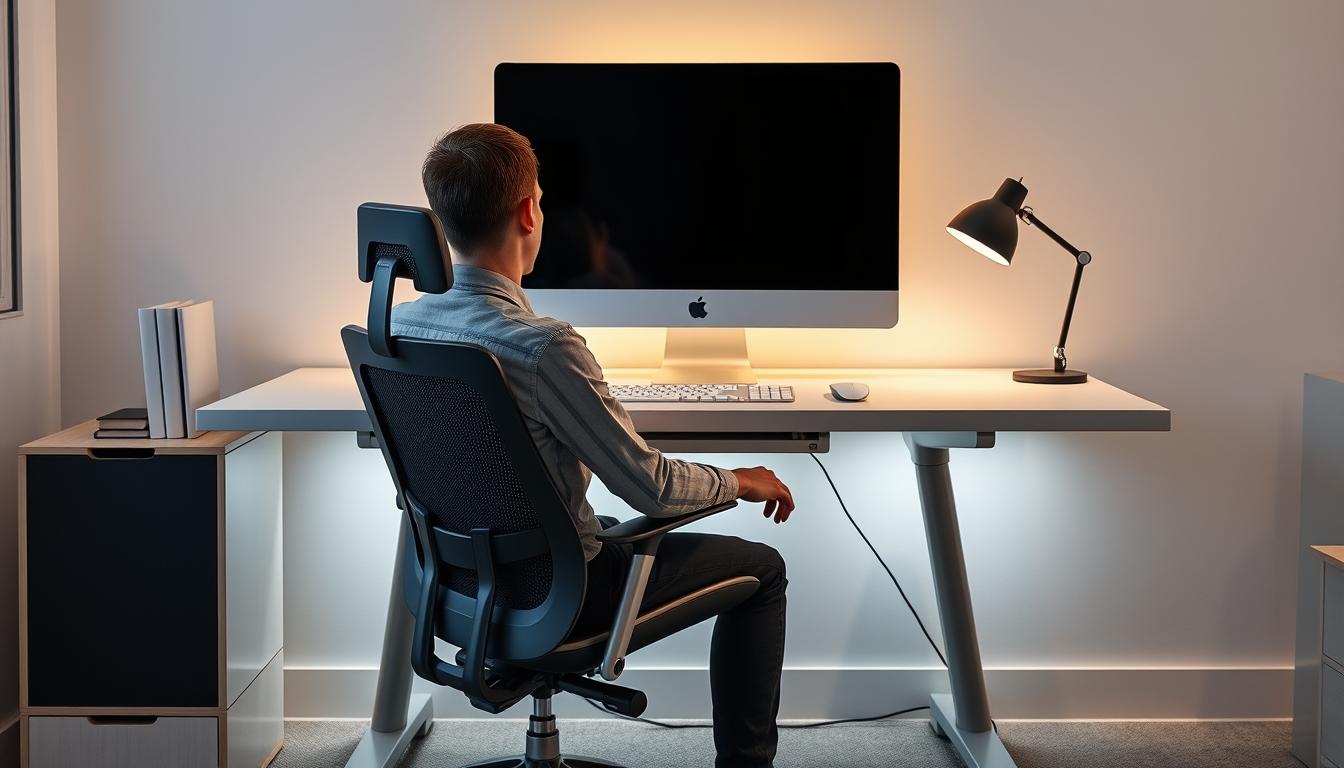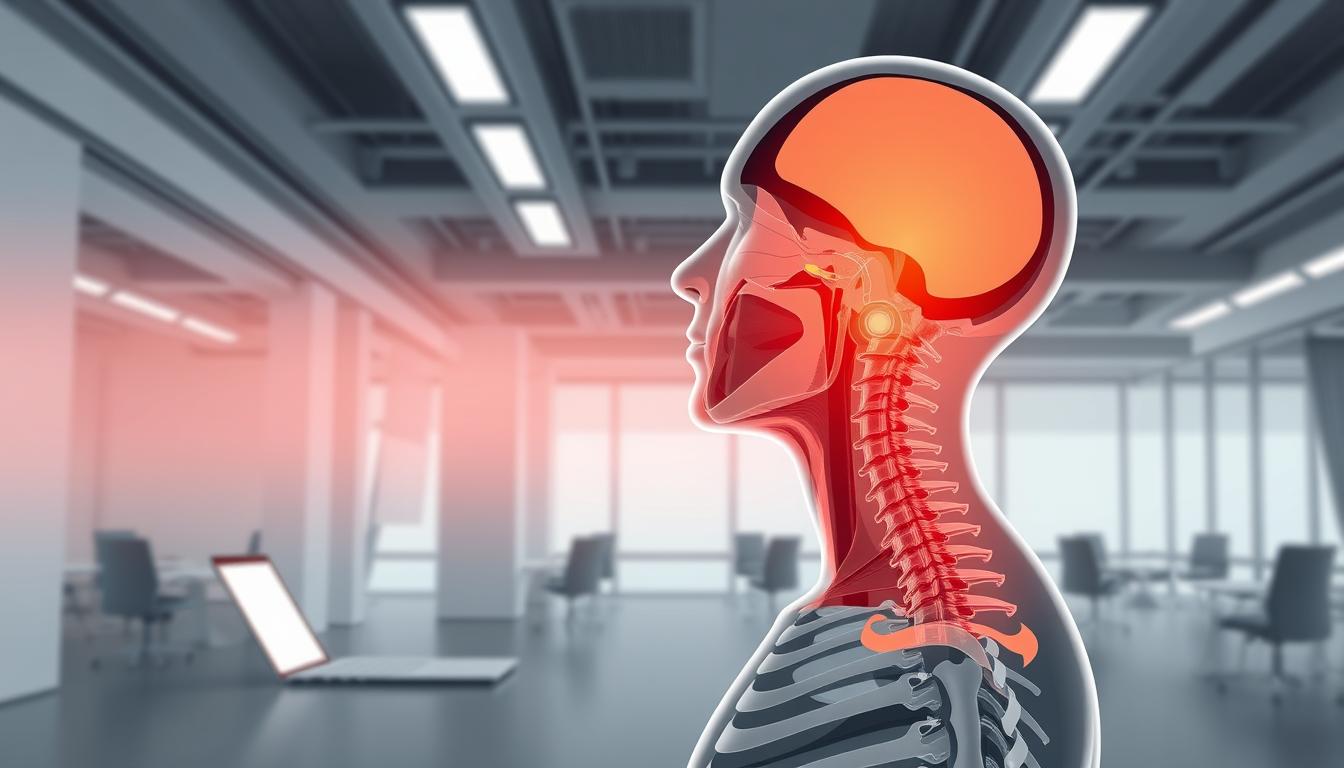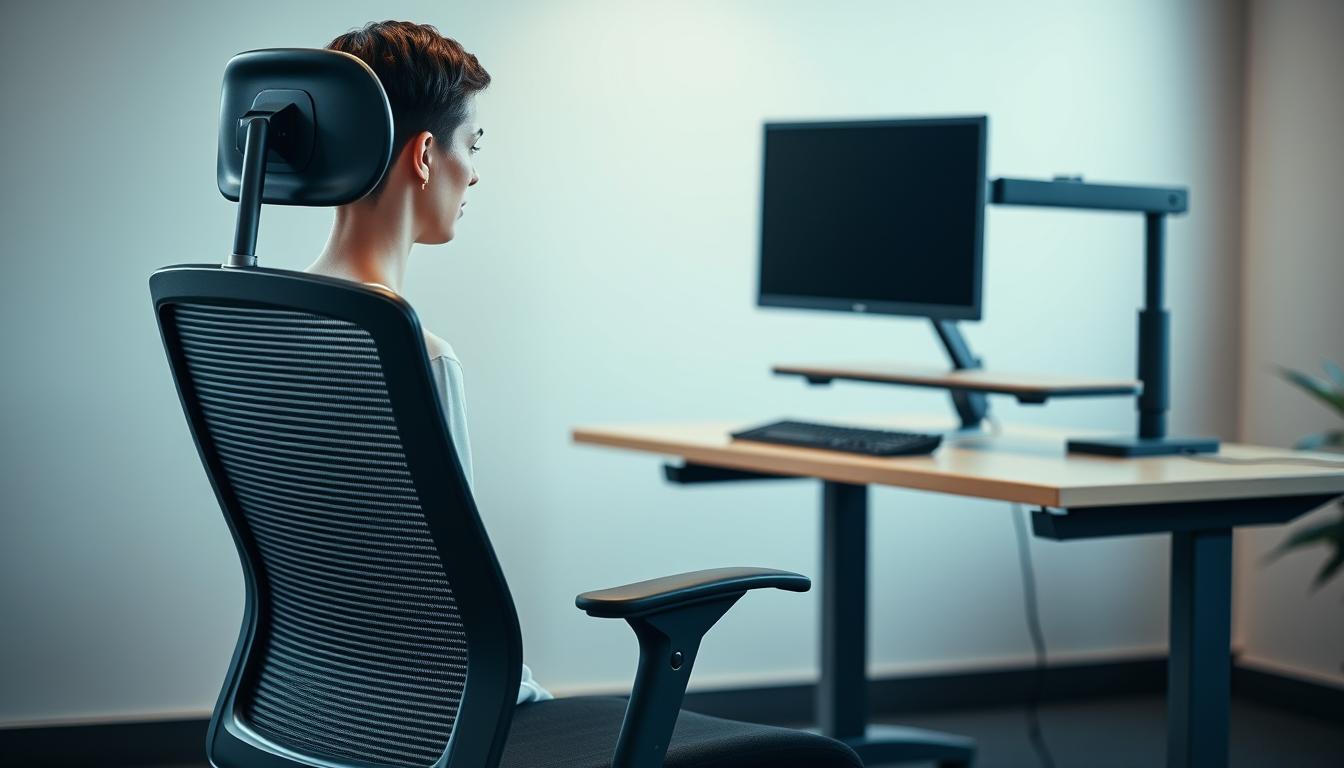As more people work from home, video meetings have become common. But, they often lead to discomfort and tiredness from too many video calls. It’s important to stay comfy and keep up productivity during these online sessions. Using ergonomic tips can help greatly.
Understanding how ergonomics makes remote work better is key. It improves your whole experience. It deals with fixing your sitting position, organizing your work area, and using the right tech. This way, you can avoid the pains from being in video meetings for too long.
Understanding the Importance of Ergonomics in Remote Work
Ergonomics is key to making remote work comfy by making a space that fits personal needs. It’s really important now that working from home is more popular. The right setup helps workers stay comfy and not get tired from too much screen time.
Good ergonomics cuts down on the chance of hurting muscles or getting eye strain. Knowing how to set up a good work spot helps people work better and feel better. Small changes, like adjusting your chair and where your monitor sits, make a big difference in making work enjoyable and effective.
Identifying Video Conferencing Fatigue Symptoms
Many people today get tired because of too much video calling. Knowing when you’re getting tired is key to doing well and staying happy when working from home. Signs that you’re getting too worn out from online meetings include:
- Eye strain, resulting from prolonged screen exposure
- Headaches, which can stem from focusing intently during virtual calls
- Shoulder and back pain due to poor posture and ergonomic setups
- A general sense of lethargy, often exacerbated by back-to-back meetings without sufficient breaks
Being tired from too much video calling can really change how well someone works. Notice these tiredness signs early on. Then, take steps to feel better. Making sure to take breaks and having good meeting habits can help fix this tiredness. Plus, it makes the experience online much better.
Ergonomic Tips for Long Calls and Video Meetings
Long video meetings can cause discomfort. It’s key to use smart tips for a better experience. By managing screen time and trying other methods, your teleconferencing gets much better.
Reduce Screen Time When Possible
Making video calls shorter is vital for your comfort. Avoid scheduling many meetings in a row and take breaks. Regular breaks reduce eye strain and fatigue from looking at screens too long. Trying phone calls instead of video can also cut down on screen time and keep you engaged.
Implementing Teleconferencing Alternatives
Using different ways to communicate can improve your conference calls. For example, walk or stand during calls to stay energized. These changes make meetings more lively and interesting. Mixing video chats with in-person meetings or phone calls can also be effective.
Optimizing Your Workspace Setup
A well-organized workspace boosts comfort and productivity, especially for video meetings. It involves choosing suitable furniture and setting up tech properly. Picking the right ergonomic chair and placing your monitor correctly are key. These steps help create an efficient setup for long hours in front of a screen.
Choosing the Right Chair
Finding the right ergonomic chair can change how you feel all day. Look for these important features:
- Adjustable height to match your desk.
- Strong lumbar support for your spine’s curve.
- Swivel base for easier movement.
- Armrests to ease shoulder pressure.
Quality chairs help make your workspace better and lessen tiredness during long calls.
Positioning Your Monitor Correctly
Correct monitor position helps avoid neck pain and makes viewing easier. Here are tips for the best placement:
- Keep the monitor at eye level to prevent bending your neck.
- Place it an arm’s length away to protect your eyes.
- Tilt the screen to improve visibility and minimize glare.
These easy steps can greatly improve your workspace, making video meetings more productive and comfy.
Utilizing Technology for Comfort
In our digital world, using tech for comfort really boosts our video meeting experiences. It cuts down on discomfort and makes us more productive. Tools like blue light glasses and laptop stands deal with common remote work issues.
Blue Light Blocker Solutions
Staring at screens for too long can hurt your eyes. Blue light glasses help avoid this by blocking bad blue light. They make video chats easier and protect your eyes, helping you stay connected without harm.
Adjustable Laptop Stands
Keeping your laptop in the right spot is key for comfy meetings. Laptop stands raise your screen to eye level, easing neck and back pain. This smart move not only helps your back but also makes working feel better.
Incorporating Breaks into Your Schedule
Taking breaks regularly is key to keeping your focus and productivity high during video calls. Without breaks, meetings can become tiring and less effective. Planning breaks during video conferences gives everyone a chance to recharge.
Adding short breaks for stretching and moving around is very helpful. These quick pauses boost circulation and clear the mind. This makes it easier for people to participate well in discussions. For meetings longer than an hour, it’s important to include these breaks. They help keep everyone sharp and productive.

Maintaining Proper Posture Tips
It’s key to keep a good posture during video calls to stay comfortable and work well. Sitting right helps avoid pain and tiredness from long meetings. Use good posture tips to sit in a way that’s best for your body during online chats.
Sitting Position and Back Support
For the best way to sit, make sure your back fills the chair. Your feet should be flat on the ground. This stops bad habits like slouching, which happens a lot during video talks. Back support is great for keeping your spine’s natural shape and staying upright.
Try using things like footrests to make sitting even better. They help keep your legs right so your back and hips don’t hurt. Check how you’re sitting often to keep your posture right. This makes video calls more fun and you get more done.
Lighting Solutions for Video Conferencing
Having good lighting can make video calls much better. It not only makes the call look clear but also makes you more comfortable. Knowing about different kinds of lights can help improve how you look on screen. Both sunlight and lamps have their benefits, helping to make your video presence better.
Natural vs Artificial Lighting
Natural light makes you look good and can even make you feel happier and more involved in meetings. If you can, face a window to use daylight best. Use curtains or blinds to keep bright light out of your eyes, making sure your face is evenly lit.
When you don’t have enough natural light, artificial lights are the way to go. Buy good lights, like ring or softbox lights, for steady and soft lighting. They help avoid shadows and make you look clearer on calls. The right lights can also keep your eyes from getting tired and make sure everyone can see you well.
Engagement Techniques During Virtual Meetings
Having good engagement techniques is key in all video meetings. People often lose focus, which can make them tired. To fix this, make meetings interactive by asking questions that need more than a yes or no answer. This method makes the discussion lively and keeps everyone involved.
Using the chat function helps get feedback instantly and boosts involvement. This lets people quickly share thoughts and reactions, improving the meeting’s engagement. Also, try adding tools like polls or quizzes. These add fun and keep everyone engaged, even from afar.
Keeping a lively atmosphere is important to keep attention during meetings. Using visuals like slides or videos helps underline your points and keeps attendees awake. If both leaders and participants get better at online communication, online meetings will go much smoother.
Conclusion
Using ergonomic practices helps in making video meetings more comfortable and keeps us healthy at work. With more people working remotely, these practices make our workspaces better and help us do our jobs more effectively. Ergonomics can lessen tiredness and make us more involved and effective in our virtual meetings.
Following the advice shared in this article can help create a healthier work environment and improve our video calls. When we focus on ergonomics, it benefits both the workers and the companies they work for. It builds a culture that cares about health and working smart. In the end, paying attention to ergonomic practices makes working from home much better and more productive.



